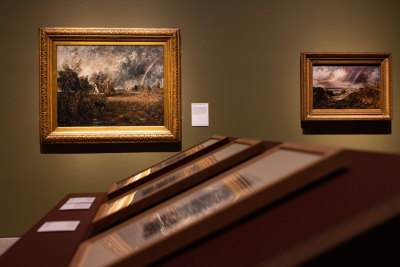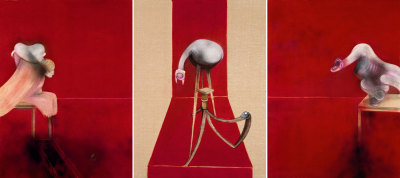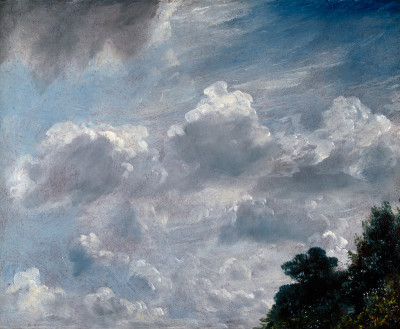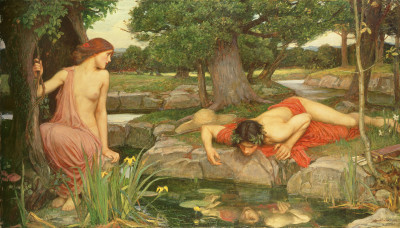Artist of the month: January 2014
Artist of the month: January 2014
Robert Anning Bell RA
By the RA Collection team
Published 1 January 2014
Robert Anning Bell presented ‘The Women Going to the Sepulchre’ to the Royal Academy as his diploma work on his election as a Royal Academician in 1922.
-
The work depicts the Virgin Mary leading a group of holy women to Christ’s tomb, moments before they discover his body has disappeared. The women carry oils to anoint Christ’s body. Mary Magdalene walks at the centre of the procession, identifiable by her long red hair. There is a sense of stillness and sadness to the painting that gives a strong impression of the mood in the days before the news of Christ’s Resurrection. The work reveals the influence of early Renaissance frescoes upon Bell in its spatial flatness and colour palette. Bell’s interest in Italian art was amplified by his extended travels in Italy. The lack of depth to the scene also shows Bell’s interest in low relief sculpture, which he regularly produced in collaboration with Sir George Frampton RA.
Bell worked in a wide variety of media, frequently showing applied artworks with the Arts and Crafts Exhibition Society and participating as a member of the Art Workers’ Guild, as well as practicing painting and sculpture. Bell’s work as a book designer and illustrator was well-regarded and influential from the mid-1890s onwards. Bell was working in time that has been referred to as the golden age of book illustration, as advances were made in printing (including colour printing) and literacy rates increased. Bell’s generation of illustrators, lasting until just before World War II, included such figures as Arthur Rackham, Kay Nielsen, and Edmund Dulac. In common with much of his output Bell primarily chose to illustrate subjects from the Bible, fairy tales, and the Romantic poets. This reflected the fascination that many Victorian artists and writers held with legends and fairy stories, exemplified by the prominence of children’s book illustration in particular.
-

Robert Anning Bell RA, Re-enter Ariel, invisible, playing and singing; Ferdinand following, 1901.

Robert Anning Bell RA, Calibani, 1901.

Francis Derwent Wood RA, Caricature of Robert Anning Bell RA, 1922.
-
His illustrations for Shakespeare’s The Tempest are among Bell’s best-known works in this genre. They are line-blocks, a photomechanical type of engraving developed by the late nineteenth century. The process enabled a greater degree of curvature and linearity than was possible in engraving, an advancement of which Robert Anning Bell takes advantage. The first illustration shows the spirit Ariel invisibly guiding Ferdinand so that he may chance upon Miranda and fall in love with her [below left]. Bell’s depiction of Ariel and Ferdinand reflects the new Symbolist and Aesthetic concept of masculinity as more sensitive, physically delicate and androgynous, moving away from traditional Victorian notions of manhood. This way of depicting figures shows the mutually influential relationship he may have had with fellow illustrator Aubrey Beardsley. The emphasis on swirling lines and delicacy in both also shows a tendency towards the Art Nouveau movement emerging at the time.
The second illustration shows Caliban [below centre], the son of the witch Sycorax. Caliban is crouched before Ariel, who is imprisoned in the tree by Sycorax and soon rescued by the sorcerer Prospero. Bell here shares his Symbolist contemporaries’ interest in fantastical creatures and the juxtaposition of the beautiful and the grotesque, in the striking difference between Caliban and both Ariel and the border of beautiful mermaids. Mermaids were a popular motif in contemporary art at this time , carrying with them associations of beauty but also danger and strangeness.
Francis Derwent Wood’s caricature of Robert Anning Bell [below right] gives a casual, fleeting impression of the artist that is more intimate than a formal portrait. As is inscribed on the work, the drawing was executed at a Royal Academy club dinner. The work gives a sense of camaraderie and humour between the Academicians in social situations. Bell exhibited his first painting with the Royal Academy in 1885 and exhibited with the RA annually from his election as an associate member in 1914. Bell also worked as a lecturer at the Glasgow of school of Art, University College Liverpool, and as a professor of design at the Royal College of Art.
See more works by this artist in the RA Collection.
-

Robert Anning Bell RA, The Women Going to the Sepulchre, 1912.
Oil on canvas. © Royal Academy of Arts, London.
-
About the RA Collection
Click here to find out more about the RA Collection and Library. If you would like to come and visit, we are open from Tuesdays to Fridays. Please book an appointment first by calling 020 7300 5737 or emailing library@royalacademy.org.uk







